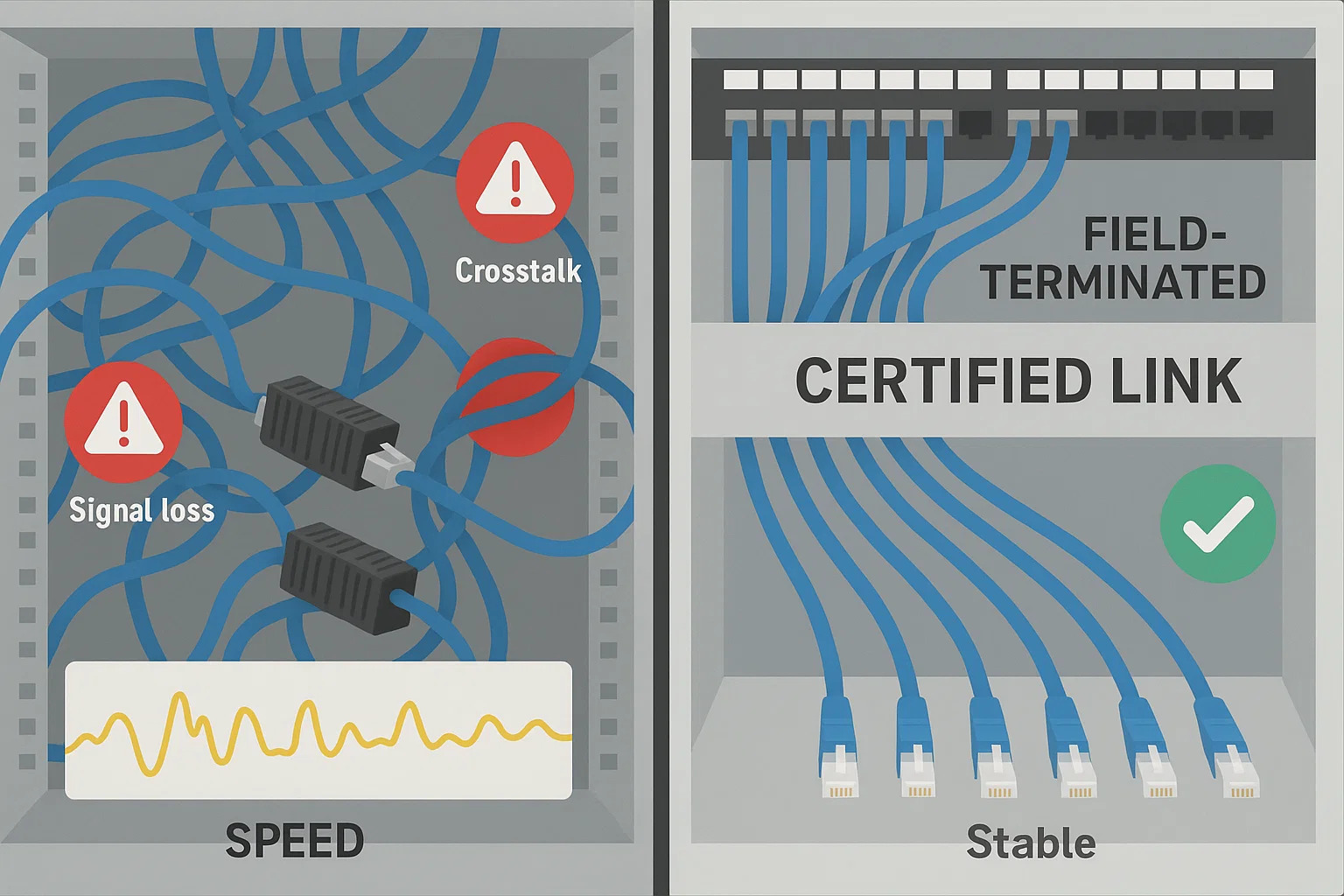Cable & Wire | High quality and excellent service at reasonable prices.
info@zion-communication.com
Author: Will Publish Time: 13-08-2025 Origin: Site
You're on a job site. The clock is ticking. The network switch is live. But one cable just won't reach. You need to extend it—now.
So you grab a standard patch cable, splice it in with a coupler, and call it a day.
Big mistake.
That quick fix might work for a few hours. But in six months, someone will be troubleshooting a flaky connection, tracing it back to that little coupler you used. And guess what? The problem isn't the switch. It's not the server. It's that connection point—weak, unshielded, and poorly terminated.
This is where a field termination plug changes everything.
A field termination plug is a modular connector you install directly onto a cable at the job site. Think of it like a "live patch" for your structured cabling system. Instead of splicing or using couplers, you terminate the cable on-site with a plug that meets performance standards—often Cat6A or Cat6.
These plugs are designed for one thing: speed without sacrifice. You get enterprise-grade performance in minutes, not hours.
And yes, they're rated for PoE, gigabit speeds, and even 10G up to 55 meters when installed correctly.
Let's be real: couplers are tempting. They're cheap. They're easy. Plug two cables together and walk away.
But here's the truth: every connection point is a failure point.
A study by the Telecommunications Industry Association (TIA) found that over 60% of network issues in commercial buildings trace back to poor cabling practices—especially unapproved splices and couplers in permanent links.
Couplers:
Break the continuity of the cable shield
Add impedance mismatches
Are rarely rated for full bandwidth
Often violate TIA-568 and ISO/IEC 11801 standards
In short, they're a shortcut that costs you more in the long run.
A field termination plug, on the other hand, maintains cable integrity. It's tested. It's certified. It's part of the link—not a band-aid on it.

Not every job needs one. But here are the red flags that say: Time to pull out the field plug.
✅ Cable is too short and cannot be replaced
✅ Access to the telecom room is limited or restricted
✅ Time is critical—downtime costs money
✅ The cable must support PoE, video, or high-speed data
These are not "nice-to-have" scenarios. These are real-world conditions that happen every day in offices, hospitals, schools, and industrial sites.
And yes, inspectors do accept field-terminated plugs—as long as they meet performance standards and are properly documented.
Step 1: Choose the Right Plug
Match the plug to your cable type. Cat6 cable? Use a Cat6-rated field plug. Shielded cable? Use a shielded plug. Don’t mix and match.
Step 2: Strip the Cable Jacket
Use a precision stripper. Remove about 1.5 inches of the outer jacket. Be careful—don’t nick the insulation on the pairs.
Step 3: Untwist and Arrange the Wires
Follow the T568B wiring standard (unless specified otherwise). Line up the wires in this order:
Orange-White, Orange, Green-White, Blue, Blue-White, Green, Brown-White, Brown.
Keep the untwisted length under 0.5 inch. Too much untwist = signal loss.
Step 4: Insert Wires into the Plug
Push the wires all the way through the front of the plug until you can see the copper tips through the inspection window. This is critical. If you can’t see them, the connection will fail.
Step 5: Crimp the Plug
Use a quality crimp tool made for field plugs. Squeeze firmly. You should hear a solid click. The pins will pierce the insulation and make contact.
Step 6: Test, Test, Test
Use a cable certifier or at least a basic tester. Check for:
Continuity
Pair mapping
Shorts or crosstalk
Let's talk about the "I'll just wing it" approach.
❌ Using a patch cable connector on a solid conductor cable
Patch plugs are for stranded wire. Field plugs are for solid. Mixing them causes poor contact and intermittent failures.
❌ Leaving too much untwist
More than half an inch of exposed wire? That's a recipe for crosstalk. Signal leaks. Speed drops.
❌ Skipping the test
"I've done this 100 times." Great. But even experts make mistakes. Test every single termination.
❌ Using cheap tools
A $10 crimp tool might save money today. But if it damages connectors or fails to seat properly, you'll spend 10 times that in troubleshooting later.
One technician told me: "I didn't test the link. It looked fine. Two weeks later, the security cameras kept dropping. Took three site visits to find the bad plug."
Don't be that tech.
Think of your network like a highway.
The switches and routers are the exits.
The servers are the destinations.
But the cables? They're the road.
You can have the fastest car in the world. But if the road is full of potholes, you're not going anywhere fast.
A field termination plug keeps the road smooth.
And here's a fact: According to BICSI, poor cabling accounts for 40–50% of network performance issues in newly installed systems. Not software. Not configuration. Cabling.
Your plug is part of that foundation.
Q: Are field termination plugs as reliable as factory-made cables?
A: Yes—if installed correctly. Modern field plugs are engineered to meet the same electrical specs as factory cables. Independent tests show insertion loss and return loss within 5% of pre-terminated cables.
Q: Can I use them for 10G networks?
A: Absolutely. As long as the plug and cable are Cat6A or better, and the link is under 55 meters, 10G is supported. Just make sure the entire channel is compliant.
Q: Do they work with shielded (STP) cables?
A: Only if the plug is designed for shielding. Look for 360-degree shield contact and grounding clips. Regular plugs will break the shield and leave you vulnerable to noise.

Q: How long does it take to install one?
A: First time: 5–7 minutes. After practice: under 3 minutes. Faster than pulling new cable through walls.
Q: Will inspectors accept them?
A: Yes. The 2018 update to TIA-568-D includes field-terminating plugs as a recognized method, provided they are listed and performance-verified.
Q: Can I reuse a field plug?
A: No. Once crimped, the contacts are permanently set. Trying to reuse it will damage the wires and create a weak connection.
Contact us for more information

Will is the Copper Cabling Product Manager at Zion Communication,
specializing in the development and marketing of Ethernet cabling solutions.
With extensive industry experience, he is dedicated to delivering high-performance
and reliable cabling products to OEM/ODM clients worldwide.
will@zion-communication.com
+86 -18268007201
